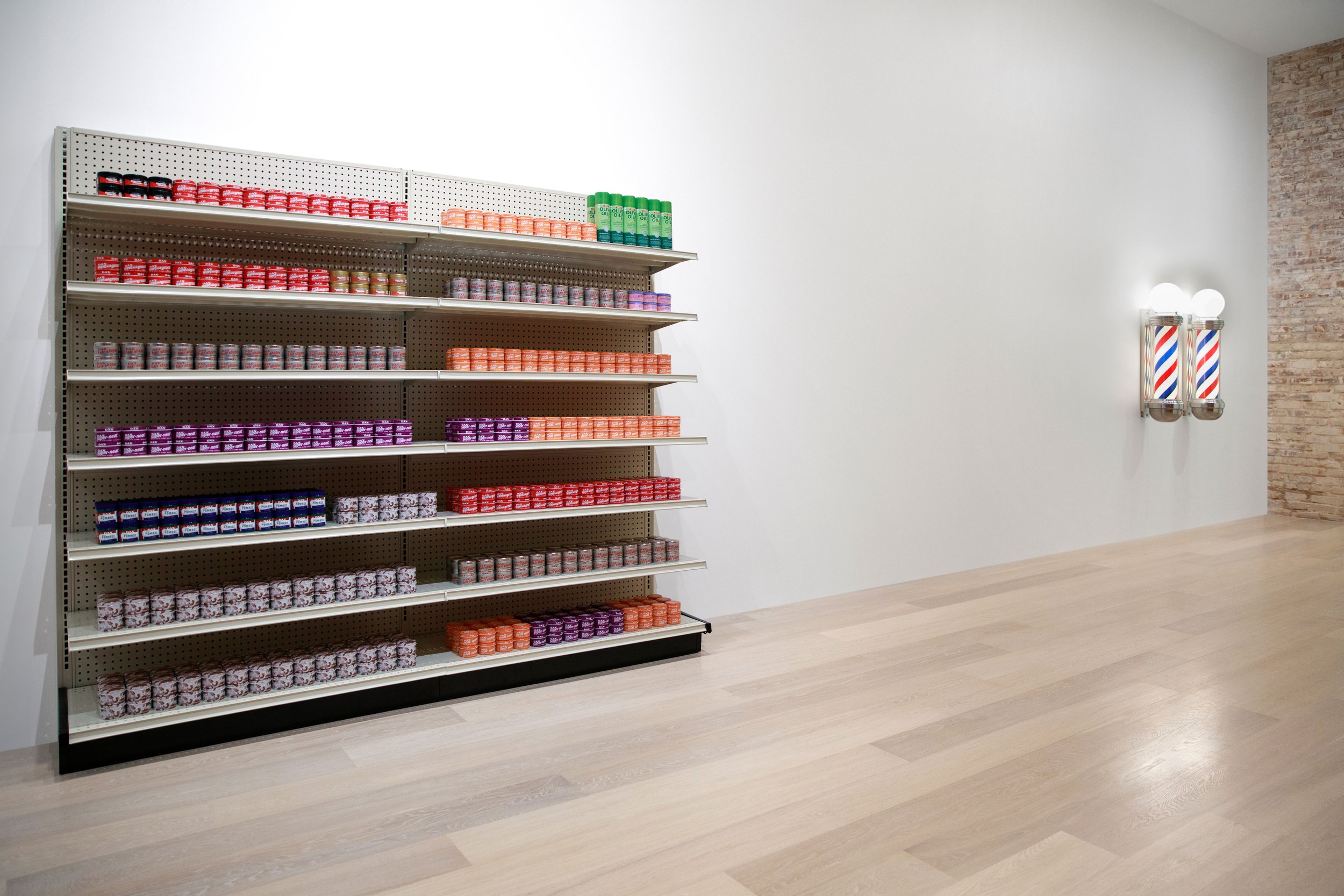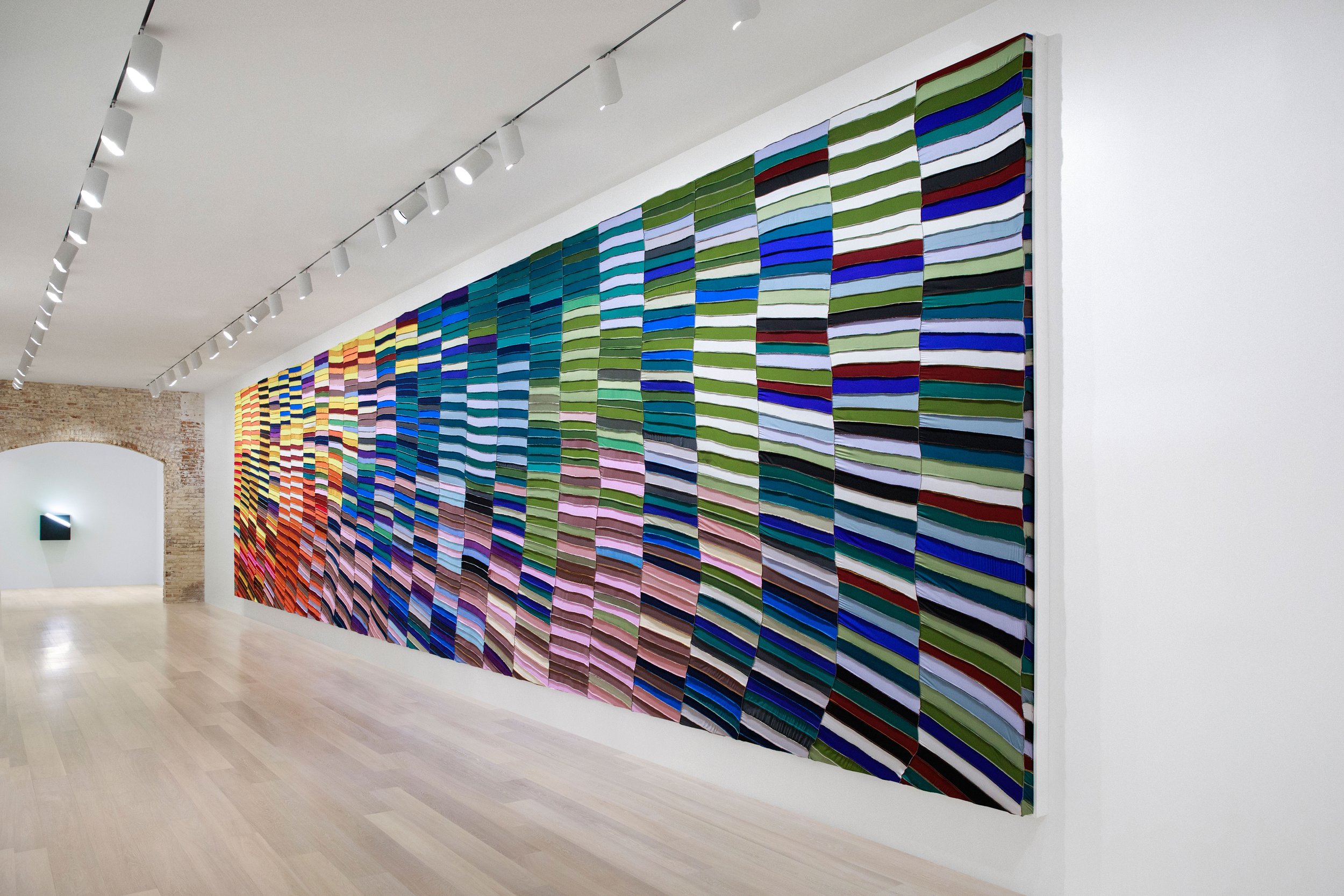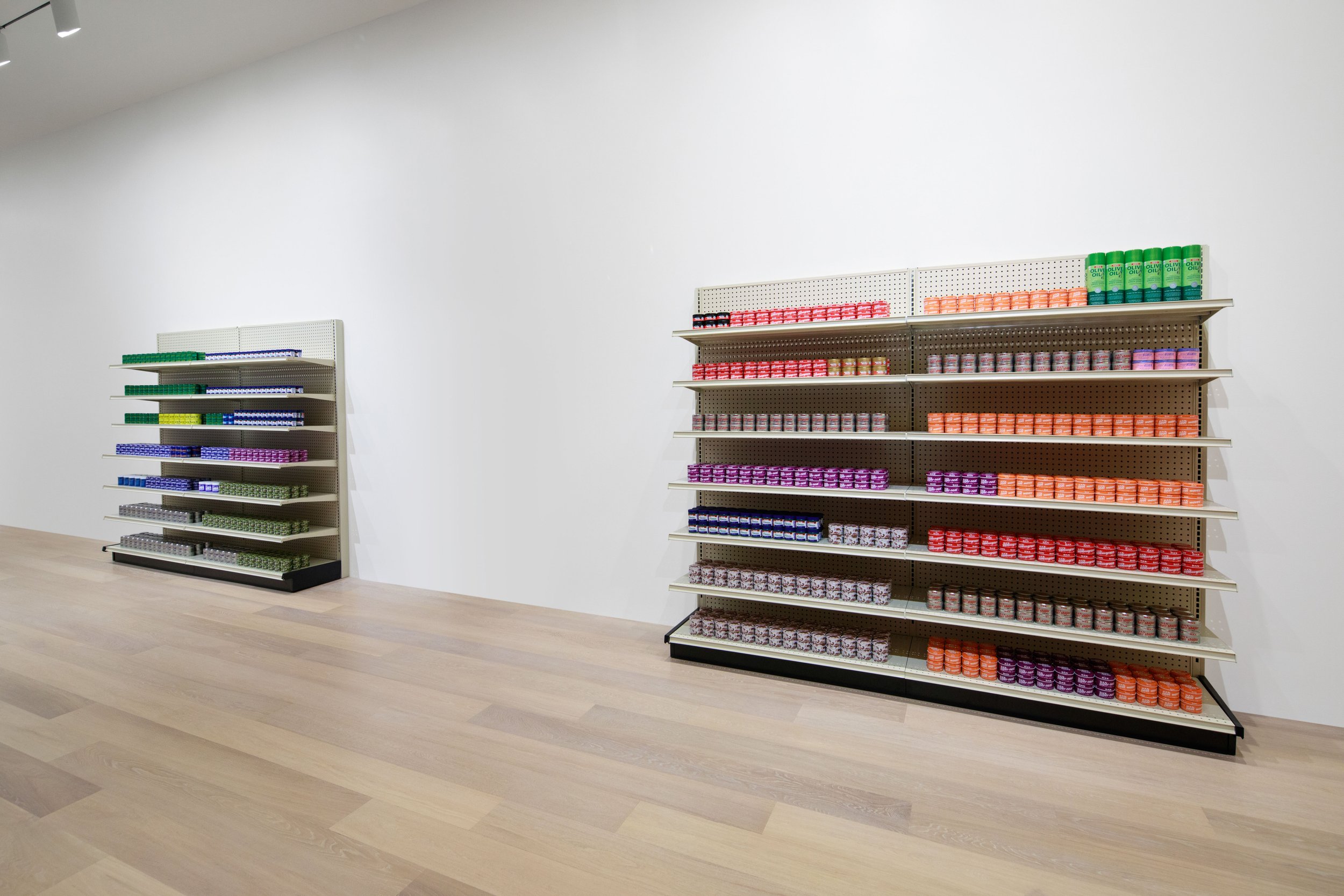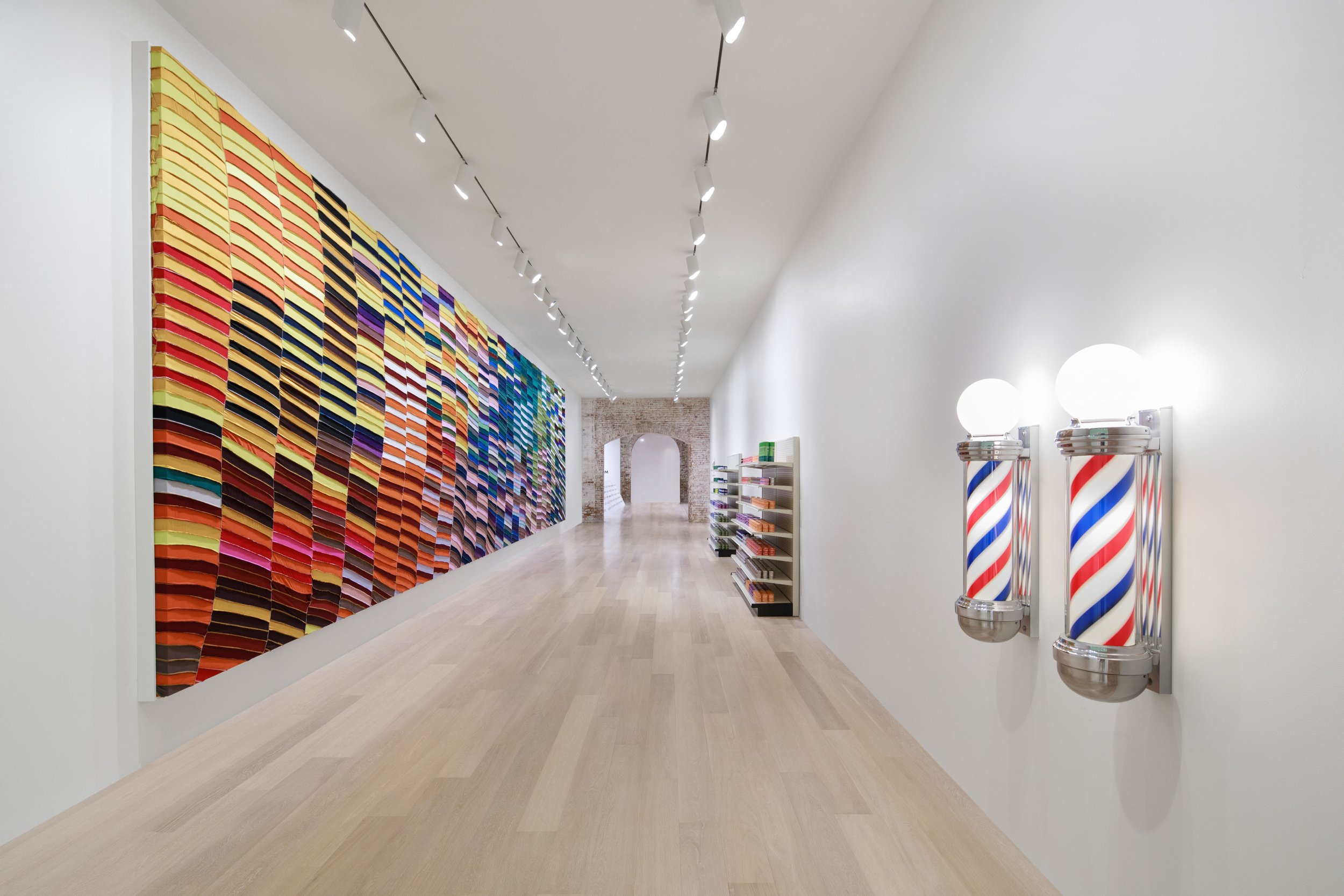Anthony Olubunmi Akinbola Shifts the Narrative of Black Hair in his SCAD Exhibition ‘Good Hair’
The exhibition is on view until December 22 at the SCAD Museum of Art in Savannah, Georgia.
Image courtesy of SCAD and Anthony Olubunmi Akinbola.
It’s not every day that you see a 48-foot-wide composition of hundreds of stitched durags on the wall of one of the country’s most notable art museums. Anthony Olubunmi Akinbola, however, is reshaping and pioneering the narrative behind Black hair through his art. Good Hair, which is now on view at the Savannah College of Art and Design (SCAD) Museum of Art, confronts the sociopolitical implications of Black hair and how it is often seen as a commodity.
Sunday’s Best is one of Akinbola’s most show-stopping, out-of-the-box pieces he’s created. In continuation of his durag paintings, the 48-foot piece evokes memories of Akinbola attending a Nigerian church in Missouri. There, they sported vibrant clothes and extravagant church outfits. The Price of Oil is an installation paying homage to the significance of beauty supply stores in the Black community. Sitting on retail shelves, Dax pomade cans signify the economy and commercialization of the Black American consumer.
We all know when we’ve arrived at a barbershop when we see the red, white, and blue spinning barber pole. Spinnin’ represents one of the earliest Black commercial enterprises, which also served as a space to gather and organize during the Civil Rights Movement. Barbershops weren’t just a space for haircuts but for community building, resisting, and achieving financial independence. Akinbola spoke to 1202 MAGAZINE about what Black hair means to him, how he’s shifting the narrative, and his experience working with SCAD.
Why did you choose to dedicate this exhibition to Black hair, and what does Black hair mean to you?
I based it on the material and narrative where I originally started with the work. I had done so much not to have it be specifically about Black hair, and it was a fear of being pigeon-holed. I always tried to reinforce this conversation of the ready-made and mass-produced objects and the conversation around industrialization. But deep down, it was actually about Black hair being an object that’s super political in America. I felt like I had established other narratives for the work. I could confidently and comfortably say this show would’ve been dedicated to Black hair and not doing the durag work but also working with cans and barbershop poles. It’s not that I was avoiding it, but I think the way race is discussed in art, you don’t want to not do the other things you’ve designed for the work.
Sunday’s Best was your showstopper. What was your creative process for that piece, and how did you make something on such a large scale?
When I’m making my work, I’m constantly making color palettes in the studio. I’ll make a couple, revisit them, and try to produce them into a piece. I make the work in sections, piece together, and remove some parts. It’s tough to come up with a time frame for it because it’s a fluid process. I started the painting on the top left with warmer colors. I worked with what I had and puzzled it together slowly over the course of months.
Where did you work on Sunday’s Best? It’s hard to visualize a space large enough to accommodate a piece that large.
I started in my studio and made it piece by piece. I laid a portion out on the floor, took a photo of it, folded it up, and when I started connecting it, I moved upstate. My studio is in the woods, and I have a big lawn, so I started this work on the lawn. I’d stand on top of my car to get a vantage point and see what it looked like.
Do you draw anything out?
I’ll just get right to it. I’ll start somewhere, which is why I call them paintings. They feel like I’m painting and figuring it out. When you’re working freely, you don’t know what the destination is, but you know where you can start.






Image courtesy of SCAD and Anthony Olubunmi Akinbola.
What message do you want to convey to non-Black viewers who may not understand the importance of hair in the Black community?
Hopefully, they can see the value of objects and colors. At the end of the day, outside of when I first started making the works, it didn’t matter what the composition was because I knew the power of the material and was able to bring it into art. I do think that came from a very specific and experiential space. After some years, I stopped thinking about being Black when I was painting them to remember that this is the power of an object. That is universal. People see things and compositions in the world or might even be at a store and see how they set up the merchandise on display. That’s the child in us. There’s also a part of it they’re not going to understand. That was the goal of the work, too – it’s like FUBU. That applies to all work. There’s work specific to races and genders.
I agree. When I saw the hair product cans in your exhibition, I thought about how some people have never even been in a beauty supply store.
Exactly. It feels very familiar to me. The beauty supply store is literally home, and that’s what I want to relish. Before I went into art spaces, I didn’t feel like it was a space for me. I felt very alienated. I felt like I had a chip on my shoulder. I was really dedicated to transforming this space and changing the power dynamic in this space to be comfortable for me.
Did you feel alienated because of where you grew up?
The art world I always knew was Eurocentric and elitist. I wasn’t even able to get into some of the museums just because they were too expensive for me. So, bringing durags, hair grease, and whatever I feel is informal into that space where it can be idolized and looked at does something for the people who are also familiar. I don’t own the narrative; it’s collective.
Good Hair felt very refreshing. I can’t recall any museum displaying durags or hair grease in an exhibition. You’ve been doing the durag and Black hair motifs for a while. How does this exhibition feel different and evolved from your previous works?
This is the first time I’ve really been able to work with color in a more mature way. I feel like I’ve been doing all of these studies, and smaller works are usually more studies for me. When you have the opportunity to work on a large scale, you can work with hundreds of colors to blend and play with them. This is the start of me making stronger work and being able to work at scale and with more colors.
You grew up in Missouri and attended a Nigerian church. How did the vibrant culture, heritage, and environment relate to your achievement of Good Hair?
Nigeria, Africa, and even South America are always very colorful. There’s always music outside, and when you go to church, everyone is dressed up. Whether you’re at a Nigerian church in Nigeria or America, you see it. Early on, I thought about where I would sample or take color from to apply it to my art. I always knew conceptually that there was something about harvesting that color and having that conversation and narrative that felt very direct and real. It was nice to bring something personal into work that is also meant to be removed from me. It’s not figurative work. I’m not specifically talking about my family members or friends in it. I’m talking about the very material that then becomes very personal to people. It makes them think about moments in their pasts or moments around their hair. Bringing that context makes that painting more personal to me in a way that’s more so about the experience I had looking at the color. Also, I think the church is super important to my mom, and she’d always call me to ask if I went to church that day. I recently lost her. She passed away, and it’s a hard truth that I’ve had to accept that almost everyone has to go through this. Through that piece, there is a portion of it meant to honor her. She used to sew, and I would help her. When you’re making conceptual art, it can be very removed from you, but I have to remember that I’m a human and making the work – there are very personal parts to the work, even if they’re hidden Easter eggs.
That’s a beautiful perspective to have on the work. You completed Sunday’s Best at SCAD. What does that mean to you?
I was really excited to show this piece at SCAD because I became an artist when I was in college. Being able to have art in a university context where students have access to it means they don’t have to fly to New York or go to the gallery where it’s more commercial. The work can be in a university environment and can be discussed as such. You can talk about the nuances and politics, and I really wanted the discussion around the work to be there, too. It’s down south, in a place different from the city. That was always really important to me, being from Missouri. I think people looking at conceptual art outside of New York is very exciting, especially to see their reactions.
Are there any other themes or motifs you want to explore besides Black hair?
Recently, I’ve been trying to look at concepts versus objects. Games and game theory have been very interesting to me. Maybe I’ll start to make different games as the artwork. That could be anything from designing an actual game like a physical, interactive board game or even hosting a game show as performance art. I have these installations I do where there’s a wall of lockers or safe deposit boxes. You can only play once, but I put objects in all of them, and you can pick them and win a stack of money or objects. It’s not always something you’ll necessarily want. I put a scorpion in there, a piece of chewed gum, and a napkin from a lunch that I thought was important. It goes back to objects. I’m really trying to lean into the experiential side of art and not having it be about money and selling, but more democratic.

